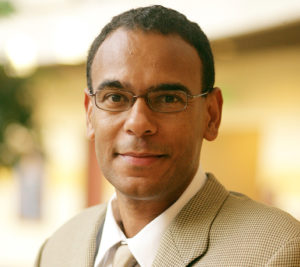By Web Communications
This post was written by Randy Horick.
David Owens, now a Professor for the Practice of Management and Innovation at Vanderbilt Business, has always been interested in how things work. “I’m genetically an engineer,” he half-jokes.

David Owens
By his own admission, he went to college at Stanford to learn how to make stereos. Owens was fueled by a love for music; he drummed for Bay Area punk bands like Swirl Happy and Whipping Boy. He initially dropped out of school and took a job in a high-end stereo shop because he found it “boring” to stare at the back of the head of his physics professor, who spent most of class time facing the blackboard instead of engaging with students. Owens wanted something more hands-on.
Fortunately for his field and future students, he returned to Stanford and eventually earned a Ph.D. And instead of simply studying how things work, he sought to understand how the makers of new things work together.
His doctoral dissertation involved what Owens calls the “ethnography” of an R&D startup. “I spent a year going to (the startup’s) meetings and trying to understand their culture,” he says, “and I ended up studying their status and hierarchy.” The key takeaway from his research: “If you don’t give people a structure, they’ll create their own, and only if you’re lucky will it be a structure that works for you.”
The research led Owens to think more about how companies “do innovation” — which led to more research. After he came to Vanderbilt in 1998, it also led to an epiphany: The concepts he was teaching in a course on leadership, he realized, “could kill innovation.”
In response, he wrote a book on the subject: Creative People Must Be Stopped! In the book, he identified six basic impediments, or “constraints,” to innovation. He categorizes them as individual (failure to generate or recognize good ideas); group (adverse social dynamics within the organization); organization (ineffective structuring of people and resources); industry (when the market fails to recognize the value of new ideas); societal (when society does not believe a new idea, such as human cloning, is safe or ethical); and technological (where some things are just hard to do).
Owens jokingly calls these his “general unified theory of constraints.” He draws them as overlapping circles on a blank sheet of the 18 x 24-inch notepad that always sits on his desk. Innovation, he argues, happens when people figure out how to overcome or work successfully within these constraints.
In any number of ways, Owens is still working on the problems of how to lead people amid uncertainty, structuring organizations that encourage “lateral communication,” and thinking radically without getting punished by the market.

Exterior of the Wond’ry
At Vanderbilt, he authored the vision for the Wond’ry — the university’s open-to-all collaboration hub for innovation that “is very close to my heart,” he says. The animating idea, he says, is to facilitate cross-pollination of ideas among students from different backgrounds, programs and disciplines. As an example, he cites a professor whose work in the history of science led him to collect and display virtual reality devices. The display, in turn, inspired a Ph.D. student in psychology to consider how virtual reality might be used in treating addictions. “He never would have had the idea without being exposed to the history of science,” Owens says — and wouldn’t have been exposed to the history of science by working in traditional academic silos.
The Wond’ry, where students can produce prototypes of the ideas they envision, is an ideal spot for the kind of experiential learning that Owens has favored ever since he grew tired of looking at the back of his physics professor’s head at Stanford. It’s an approach that extends to his university course — “Design Thinking, Design Doing” — and to his executive education programs on strategic innovation.
Owens, who has won awards for his teaching, re-oriented the design class so that students watched his lectures at home on video, allowing them to devote their actual class periods to experiential learning — “the stuff I couldn’t get to before because there wasn’t time,” he says. Students have opportunities to work with real companies to solve innovation challenges. And people in those real companies have access to the ideas and practices as well: Over 140,000 people have been enrolled in the video-based MOOC (massive open online course) he created based on his Vanderbilt course.
At home, Owens has his own Wond’ry of sorts: a two-story shop he built in his back yard. Inside, where the CD player is usually rotating jazz (Thelonius Monk and Charles Mingus are among his favorites), he built his own microbrewery. There’s even “a little corner where you can do electronics,” he says — demonstrating that you can, after all, simultaneously build stereos and stay in school.